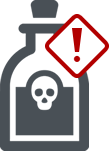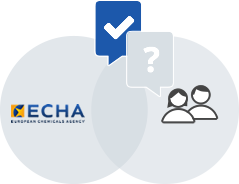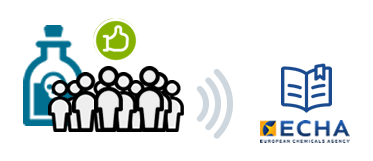Authorisation process
Authorisation process
Phase III: Application for authorisation
This phase consists of the following steps:
Companies that want to continue using a substance included in the Authorisation List after the sunset date need to prepare an application for authorisation and submit it before the latest application date. The latest application date and the sunset date are specified in the Authorisation List.
Learn morePreparation of the application
An application for authorisation can be submitted for:
- one or several uses
- one or a group of (similar) substances
Applicants may apply for authorisation for their own use or uses for which they intend to place the substance on the market.

Companies should check whether any of the substances they use or place on the market are included in the Authorisation List.
Learn more
If their substances are included in the Authorisation List, they should check that their uses are not exempted from authorisation (examples of exempted uses include intermediates and scientific research and development).
Learn more
If any of the substances are affected by authorisation, the next step is to develop a strategy on how to proceed in:
- Searching for safer alternatives and assessing whether it is possible to substitute to them.
- Assessing the importance of the substance to the business and supply chain.

If the conclusion is to continue using the substance or placing it on the market after the sunset date, then the company should apply for authorisation.
Notification and teleconference based information sessions


Applicants (manufacturers, importers or downstream users of the substance) notify their intentions to submit an authorisation application to ECHA.

Applicants can request (when notifying or later) a teleconference based information sessions with ECHA to ask case-specific questions and clarify regulatory and procedural issues related to the authorisation application process.
Learn moreFinalisation of application
Applicants should be transparent and avoid any unnecessary confidentiality claims in the public versions of the reports. Justifications will need to be provided for any information claimed confidential.

Submission of the application to ECHA
Applicants submit their applications for authorisation to ECHA. Learn more

It is recommended that applicants send their application during the first days of the submission window to reduce the risk of missing a specific period's deadline due to failing the business rules check.
Learn moreECHA will check that the authorisation application conforms with the business rules and that the package describing the uses contains the necessary information for the consultation.
If the application is complete and can be processed, then the invoice can be prepared and sent to the applicants.
Once ECHA has received the payment by the specified deadline, the application is considered received.
The application is then ready to be evaluated by the Committees for Risk Assessment (RAC) and Socio-economic Analysis (SEAC) supported by the ECHA Secretariat. As part of this process, a consultation is organised to gather information on possible alternative substances or technologies for the uses applied for.
Consultation
ECHA launches a consultation on alternatives for each combination of applicant/substance/use applied for.
Interested parties (e.g. alternative providers, citizens, non-governmental organisations or authorities) are invited to submit information on possible alternative substances or technologies for these uses.
The consultation lasts eight weeks. Public versions of the comments, as well as any responses to them by the applicant, are published on ECHA’s website.
RAC and SEAC opinion
This step consist of the following substeps:

- Questions to the applicant from the RAC and SEAC rapporteurs.
- Possible trialogue between the applicant, RAC & SEAC and any third party that has provided information on alternatives.
- Draft opinion by RAC and SEAC.
- Final opinion by RAC and SEAC, taking into account the applicant’s possible comments on the draft opinion.
Opinion development Questions to applicant from rapporteurs
The Committees for Risk Assessment (RAC) and Socio-economic Analysis (SEAC) will prepare their draft opinion, including on whether the application contains all the necessary information specified in Article 62 of REACH, within 10 months of receiving the application.
RAC
Risk Assessment Committee
For RAC’s part, this includes assessing the risk to human health and/or the environment arising from the uses of the substance, including the appropriateness and effectiveness of the risk management measures as described in the application and, if relevant, an assessment of the risks arising from possible alternatives.
SEAC
Socio-Economic Analysis Committee
For SEAC’s part, it includes assessing the socio-economic factors and the availability, suitability and technical feasibility of alternatives associated with the uses of the substance as described in the application and of any third party contributions.

The opinions are based on:
- the application;
- any information received during the consultation; and
- any further information that the applicant or interested parties have provided.
The committees may request additional information from the applicant or third parties within a specified timeline.
Opinion development Possible trialogue between applicants, RAC and SEAC, and any relevant third parties
A trialogue may also be organised with the applicant, the RAC and SEAC rapporteurs and any third parties that have submitted information on alternatives in the consultation.

The trialogue is an opportunity for the rapporteurs to discuss, in an interactive manner, the applicability of the suggested alternatives and, if necessary, any other technical and scientific issues related to the application for authorisation.
Opinion development RAC and SEAC opinion
Draft opinion by RAC and SEAC
The applicant may comment on the draft opinion within two months of receiving the draft opinion.


Final opinion by RAC and SEAC
RAC and SEAC adopt their final opinions taking into account the possible comments made by the applicant on the draft opinions. If the applicant provides comments on the draft opinion, the final opinion is ready approximately four months after the draft opinion.

ECHA sends the opinions to the European Commission, the Member States and the applicant. Non-confidential versions of the opinions are published on ECHA's website.
Learn moreDecision
This step consists of the following substeps:
- Draft decision by the European Commission.
- REACH Committee vote and adoption of decision.
The European Commission prepares a draft decision on whether or not the authorisation should be granted within three months of receiving the opinions. Following the draft decision, a minimum of three months is needed for the vote in the REACH Committee and the subsequent adoption procedure, including translations, in the Commission.

Once the European Commission adopts the decision granting or refusing the authorisation, a summary of the decision is published in the Official Journal (OJ) of the European Union, and made publicly available through a database maintained by ECHA.
Learn more

The authorisation is subject to a time-limited review period.
Learn moreImplementation
This step consist of the following substeps:

Implementation Compliance by authorisation holders and downstream users
If the authorisation is granted by the European Commission, it is subject to the conditions described in the chemical safety report submitted in the application. The authorisation decision may stipulate additional conditions. The authorisation holder should also continue efforts to find safer alternatives after the decision.
Holders of an authorisation must:
Comply with the requirements of the authorisation decision when marketing and/or using the substance; and

Include the authorisation number on the label before they place the substance or a mixture containing the substance on the market (if they are manufacturers, importers or only representatives).
This has to be done without delay once the authorisation number has been made publicly available.
Downstream users covered by an authorisation granted to an actor up their supply chain must comply with the conditions of the decision and notify ECHA within three months of the first supply of the substance.
Learn more
ECHA keeps a register of the downstream user notifications and grants access to this register to the competent authorities of the Member States.
Learn moreImplementation Enforcement by Member State Competent Authorities
The national authorities are responsible for enforcing REACH authorisation.
The Commission may review an authorisation at any time if:
- the circumstances have changed so as to affect the risk to human health or the environment, or the socio-economic impact;
- new information on possible substitutes becomes available.
Review report
if the company needs to continue using the SVHC after the review period
If the authorisation holder needs to continue using the SVHC after the review period, they must submit a review report. A review may also be triggered if the circumstances of the original authorisation have changed or new information on possible substitutes becomes available.
During the time-limited review period, authorisation holders must continue looking for a suitable alternative substance or technology that would make the use of the SVHC un-necessary.

If authorisation holders need to continue using the SVHC after the end of the review period, they must submit a review report to ECHA at least 18 months before the expiry of the review period.
A review may also be triggered if the circumstances of the original authorisation have changed or new information on possible substitutes becomes available.

As part of the review reports, the authorisation holders should update all documents submitted in the original application that have changed and submit any other elements required by the conditions or monitoring arrangements of the authorisation decision.

The process for submitting and handling a review report (including the consultation) is the same as for the initial application for authorisation.
Learn more

